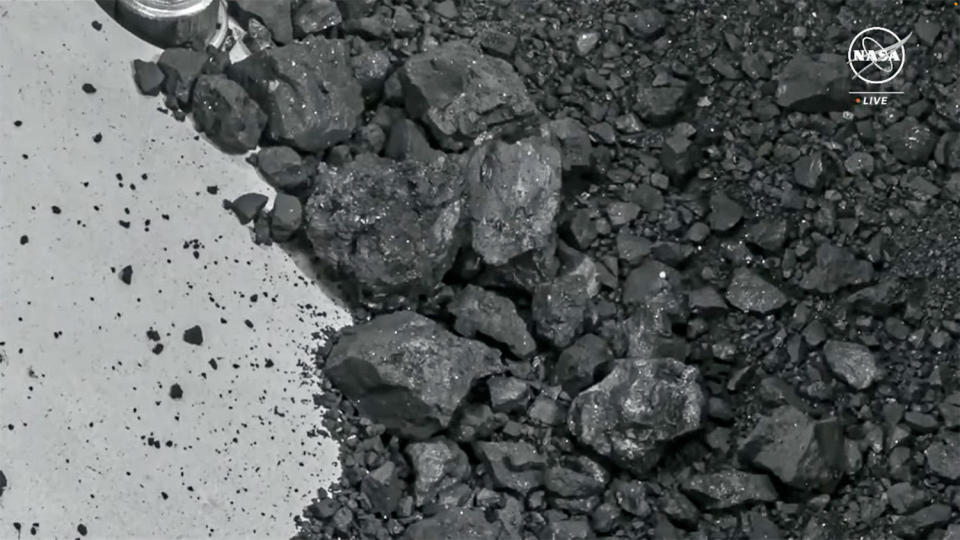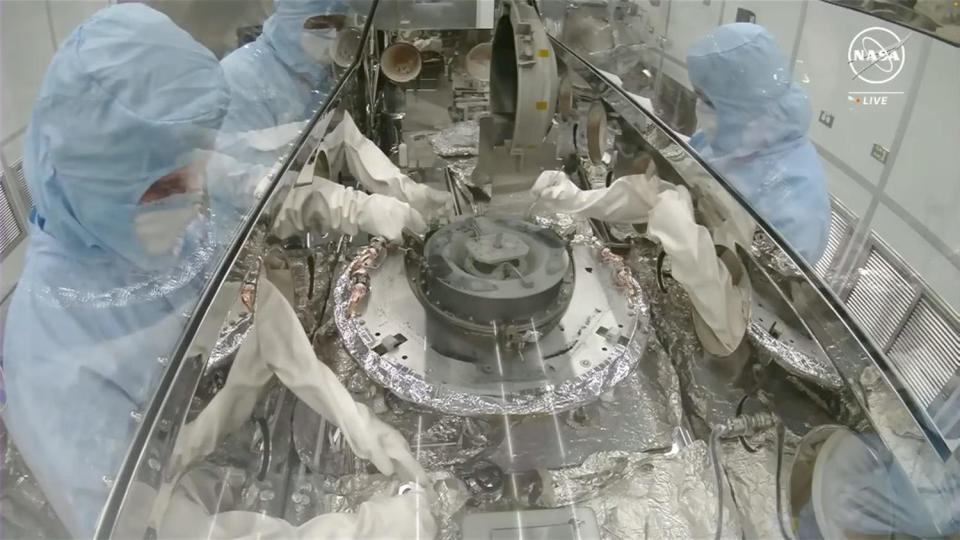Rocks and soil collected from the asteroid Bennu and introduced again to Earth final month by NASA’s OSIRIS-REx probe are wealthy in carbon and comprise water-bearing clay minerals that date again to the start of the photo voltaic system, scientists mentioned Wednesday. The invention provides important perception into the formation of our planet and helps theories about how water could have arrived on Earth within the distant previous.
The clay minerals “have water locked inside their crystal construction,” mentioned Dante Lauretta, a planetary scientist on the College of Arizona and the principal investigator of the asteroid pattern return mission, whereas revealing preliminary pictures of the fabric.
“And I wish to cease and take into consideration what meaning,” mentioned Lauretta. “That’s how we predict water received to the Earth.”


“The rationale that Earth is a liveable world, that we’ve got oceans and lakes and rivers and rain, is as a result of these clay minerals like those we’re seeing from Bennu, landed on Earth four-and-a-half billion years in the past, making our world liveable,” mentioned Lauretta.
“So we’re seeing the way in which water received integrated … in the end into planets.”
The OSIRIS-REx pattern return capsule landed in Utah Sept. 24, practically three years after the spacecraft briefly pushed its progressive touch-and-go pattern acquisition mechanism, or TAGSAM, into the the asteroid Bennu’s rubble-strewn floor.
Researchers initially anticipated to have the TAGSAM open by now, revealing the half-pound or so of fabric estimated to be trapped inside. However they have been stunned to seek out mud and small fragments from Bennu strewn concerning the inside of the pattern return capsule, simply exterior the TAGSAM.
Opening TAGSAM was placed on maintain whereas scientists eagerly examined the sudden bonus materials — which turned out to supply a tantalizing glimpse of discoveries to return.
“It has been going gradual, meticulous, however the science is already beginning,” mentioned Lauretta, a planetary scientist on the College of Arizona. “That is scientific treasure.”
The samples are being studied inside an environmentally remoted laboratory on the Texas house heart the place Apollo moon samples are also protectively housed. Preliminary examination of the asteroid mud by a robust electron microscope revealed water-bearing clay minerals, sulfides and excessive concentrations of carbon.
Together with carbon compounds and clays, sulfides are “a important ingredient for planetary evolution,” mentioned Lauretta. “It determines how shortly issues soften, and it is also important for biology. Loads of the amino acids that give construction to our proteins use sulfur to hyperlink and supply these bridges.”


NASA Administrator Invoice Nelson mentioned the captured Bennu samples characterize “the most important carbon-rich asteroid pattern ever returned to Earth.”
“The carbon and water molecules are precisely the sorts of fabric that we wished to seek out,” he mentioned. “They’re essential components within the formation of our personal planet, and they’ll assist us decide the origin of components that would have led to life.”
As soon as TAGSAM is opened and your complete pattern is categorized, about 25% shall be reserved for research by the OSIRIS-REx staff on the Johnson Area Middle. One other 4% shall be shared with the Canadian Area Company, which equipped the OSIRIS-REx laser altimeter instrument, and about 0.5% shall be given to the Japan Aerospace Exploration Company.
A small portion of the fabric shall be protectively stockpiled at a facility in White Sands, New Mexico, and the remainder shall be curated for eventual evaluation by scientists world wide.
The samples revealed Wednesday are “the fabric that leaked out of the TAGSAM after we flipped it over,” Lauretta mentioned. “Beneath that flap, there’s an entire treasure chest of fabric. And belief me, the pattern science staff cannot wait to get their palms on it.”
Outfitted with three cameras, two spectrometers, a laser altimeter and an X-ray imaging system developed by school college students, the OSIRIS-REx spacecraft and pattern return capsule have been launched atop a United Launch Alliance Atlas 5 rocket from Cape Canaveral on Sept. 8, 2016.
The spacecraft reached Bennu in December 2018, slipping into orbit across the 1,500-foot-wide asteroid for months of mapping and evaluation. Practically two years later, on Oct. 20, 2020. the spacecraft moved in and rammed the TAGSAM into the floor.
The collector, formed like an inverted pie pan, fired a jet of nitrogen fuel to fire up the soil beneath it for the time being of contact. Because the fuel exited by way of vents, small rocks and soil particles have been captured in filters.


After backing away, OSIRIS-REx’s robotic arm deposited the seize machine in an aerodynamic pattern return container that was lastly returned to Earth final month. The pattern container then was flown from Utah to the Astromaterials Acquisition and Curation Workplace on the Johnson Area Middle for 2 years of detailed evaluation.
A key ingredient of the OSIRIS-REx mission — the acronym stands for Origins, Spectral Interpretation, Useful resource Identification, and Safety-Regolith Explorer — is to study extra concerning the supplies current on the start of the photo voltaic system 4.5 billion years in the past and the way they got here collectively to kind the solar and its retinue of planets.
The composition and evolution of asteroids and comets is central to understanding the place the water in Earth’s oceans originated and even how life managed to come up from natural compounds and different chemical compounds transported to Earth.
A extra down-to-Earth cause to review asteroids and comets is the chance of potential Earth impacts just like the Tunguska occasion of 1908, when a physique measuring 200 to 620 toes throughout exploded within the ambiance over western Russia, flattening bushes throughout 770 sq. miles.
One of many objectives of the OSIRIS-REx mission is to know the composition and construction of Bennu to get a greater thought of what would possibly work greatest to deflect an identical physique on a collision course with Earth.
Docs say RSV antibody shot for infants continues to be difficult to seek out
Steve Scalise speaks after GOP selects him as Home speaker nominee
